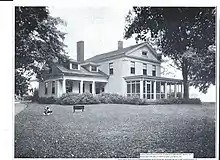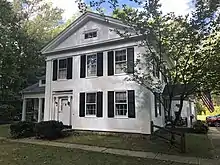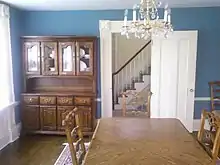Sawyer-Barrow House
The Sawyer-Barrow House, first known as the Joseph Sawyer House,[1] and then for 78 years as the summer estate Twin Maples,[2] was built c. 1825[3] for Joseph Sawyer (1778-1849) by the Western Reserve's master builder Jonathan Goldsmith.[4][5][6]




Location
The house was originally located on the southwestern corner of Mentor Avenue and Chillicothe Road in Mentor, Ohio. From 1885 to 1922 it was stop 66 on the Cleveland, Painesville, and Eastern Intraurban line.[7]
41.6786°N 81.3037°W
In 1961, it was moved a mile south to 9364 Forsythe Lane. 41.6751°N 81.3045°W
History
Arriving in 1811 from Pompey, New York, Joseph Sawyer's family was one of the earliest pioneers to settle in the Connecticut Western Reserve area of Ohio. He built one of the first Gristmills in the area and around 1825 he contracted with Jonathan Goldsmith[3] to build a new home in the Greek Revival style. By the time of his death in 1849 Joseph had amassed over 1,100 acres,[8] making his one of the largest farms in Lake County, Ohio.[9] The house remained in the family until 1883 when Joseph's grandson sold it to Luthur L. Cook, a prominent businessman who founded L. L. Cook & Brothers.
It was during this next era that the home was known as Twin Maples.[10] For the next 78 years it was the summer home to a number of wealthy Cleveland businessmen who originally used the Cleveland, Painesville, and Eastern Intraurban line to travel the 25 miles between their winter and summer homes. It was this same line that provided electrical and telephone service to the house.
In 1961, the land was purchased by a local developer, Richard Defranco, to build a gas station[11] but the house was spared as it was moved a mile up the road.[12] The house was extensively updated by another developer, Richard Swerling. One oddity was when the house was moved to the new T-shaped lot it was placed at the end of a long driveway so the old front faced away from the road and into the woods. From the road, with a new garage added, it now gives the appearance of a 1970s colonial because the old front isn't easily visible.
Jonathan Goldsmith
The house was designed and built by the architect Jonathan Goldsmith.[3][4][5] Goldsmith is considered one of the leading architects of the Western Reserve. His work was important enough that one of his homes, the Robinson House was saved by the Western Reserve Historical Society and moved to become the centerpiece of its Hale Farm & Village property.[13][14] Another of his homes, the Mathews House, was also saved at the Lake Erie College campus.[15] Both are almost identical in design to the Sawyer-Barrow house. Goldsmith was considered such a master architect of the Greek Revival style that when the Isaac Gillet House was demolished, the front door was saved and is now on permanent display at the Cleveland Museum of Art.[16][17]
Further reading
- The Architecture of Mentor, Ohio; a Guide to Historic Buildings[6]
- Mentor - a Retrospective[8]
- Architecture of the Western Reserve 1800-1900[1]
- Mentor: The First 200 Years[2]
- Historic country estates in Lake County, Ohio
References
- Campen, Richard N. (1971). Architecture of the Western Reserve 1800-1900. Cleveland, Ohio: The Press of Case Western Reserve University. p. 73. ISBN 0-8295-0196-7.
- Kapsch, Joan; Sue Muehlhauser; Kathie Pohl (1997). Mentor: The First 200 Years. Mentor, Ohio: Mentor Bicentennial Committee/Old Mentor Foundation.
- Jonathan Goldsmith, Pioneer Master Builder in the Western Reserve. Western Reserve Historical Society. 1980. ISBN 091170423X. 9780911704235. Retrieved March 2, 2021.
- "GOLDSMITH, JONATHAN". Encyclopedia of Cleveland History | Case Western Reserve University. May 11, 2018.
- Goldsmith, Jonathan (1997). Cleveland Architects Database. www.yumpu.com: Cleveland Planning Commission. p. 80. Retrieved March 2, 2021.
- Fazio, Michael W. (1973). "The Architecture of Mentor, Ohio; A Guide to Historic Buildings". Old Mentor Foundation: 15.
- Atlas of Lake County, Ohio (1898). "Mentor Township Pg 67 & 68" (PDF). Retrieved May 12, 2021.
{{cite web}}: CS1 maint: url-status (link) - Habinski, Janice A.; Prosek, Ronald L. (1988). Mentor - A Retrospective. Mentor, Ohio: Old Mentor Foundation. p. 6. Retrieved November 17, 2021.
- Matthews, S. B. (1857). "Map of Geauga and Lake Counties" (PDF). gis.lakecountyohio.gov. Retrieved November 17, 2021.
{{cite web}}: CS1 maint: url-status (link) - Cook, Luther L. (August 1, 1890). "Announcements". The Cleveland Plain Dealer. Retrieved March 2, 2021.
- Barrow, Jack (August 23, 1961). "Builder Plans to Spare Historic Home in Mentor". Painesville Telegraph.
{{cite news}}:|access-date=requires|url=(help) - Barrow, Jack (October 2, 1961). "Area Landmark Moved to Build Gas Station". Mentor Monitor.
{{cite news}}:|access-date=requires|url=(help) - "The Homes of the Garfield Children: Eastlawn (U.S. National Park Service)". www.nps.gov. Retrieved December 28, 2021.
- Barrow, Jack. "Hale Farm & Village". www.wrhs.org. Retrieved November 17, 2021.
- "Mathews House". www.lec.edu. Retrieved December 28, 2021.
- "Doorway from the Isaac Gillet House, Painesville, Ohio". Cleveland Museum of Art. October 31, 2018. Retrieved December 28, 2021.
{{cite web}}: CS1 maint: url-status (link) - "Gillet House 1889". The News-Herald. November 30, 1962. p. 20. Retrieved December 28, 2021.